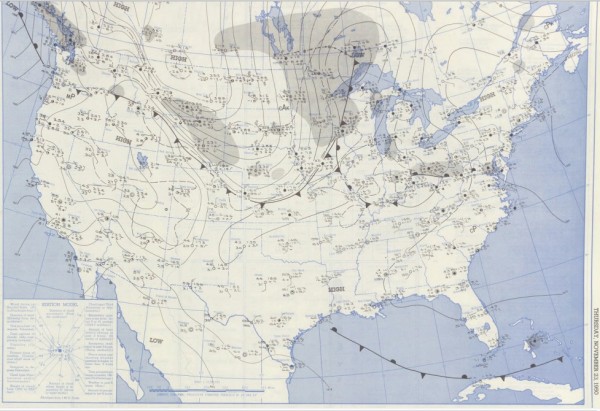On This Date in 1950: A Quick Turn to Winter
Alabamians paid little attention to the weather forecast on Thanksgiving morning, November 23, 1950. The Birmingham News carried a lead article about the many blessings of the day, including bountiful food, talking about the day’s candied yams, crisp white celery, plump olives and a golden brown roasted turkey. Headlines told of a Thanksgiving Eve crash between two Long Island Railroad trains in New York City that killed 76 people. There were hopes that the Korean War might be ending, bolstered by hints that China might be willing to sit down for peace talks.
Over 36,000 people made their way to Legion Field for the annual high school football classic at Legion Field. The game featured the Phillips Red Raiders and Woodlawn Colonels. It would raise $95,000 for the new Children’s Hospital. As the game kicked off at 2 p.m., the temperature at the Birmingham Airport was a balmy 70 degrees.
The fine holiday weather belied the fact that a major cold wave was overspreading the U.S. east of the Rockies. Birmingham’s official weatherman, Charles Bradley, warned that the mild afternoon and nice weather was going to be followed by a quick turn to winter. The afternoon highs near 70 would be replaced with overnight lows in the 30s. Highs the following day would remain steady or fall. Fans in shirt sleeves at Legion Field got a rude awakening when the temperature fell into the 50s by the fourth quarter of a 20-0 Phillips victory.
By late evening, readings were in the lower 40s with a north wind averaging over 20 mph. To the north, it was getting interesting. It was 18F in Nashville with heavy snow. It was 25F in Memphis with moderate snow and a north wind averaging over 30 mph. The snow was reaching Northwest Alabama.
By 6:30 a.m. on Friday morning, it was down to 32F at Birmingham with snow. Four inches of snow was on the ground at Tuscumbia. An inch was on the ground in the Magic City. Roads were hazardous all over North Alabama. Dozens of accidents were being reported. By late morning, US-31 was impassable as far south as Clanton. By 10:30 a.m., the mercury had plummeted further, to 21F at the Birmingham Airport.
The Alabama Crimson Tide football team boarded a charter plane at the Birmingham Airport, bound for Jacksonville and a Saturday tilt with Florida. With two losses, Alabama needed a victory to seal a major bowl bid. Tennessee was already paired with Texas in the Cotton Bowl. Kentucky coach Paul Bryant was preparing his Wildcats for a Sugar Bowl date with Oklahoma in New Orleans. The Birmingham News carried rumors that the Bear might be nosing around for a job in Texas while mentioning that Alabama was his alma mater.
In his afternoon forecast, the weatherman was calling for an overnight low between 12-15F. Good thing for Mr. Bradley that the three-degree guarantee had not been invented, because with screaming cold air advection, the temperature would already be at 15 by midnight, on the way to a low of 5F. It is the coldest November reading ever in Birmingham. The second coldest November reading ever is 13F, underscoring the significance of the record. Fresh snow would fall across the northern half of the state on Saturday as the Great Appalachian Storm spun up over Ohio.
Our late, great J.B. Elliott would have called it a cold wave. I call it just another story from the pages of Alabama weather history. Follow my weather history tweets on Twitter. I am @wxhistorian at Twitter.com.
Category: ALL POSTS, Met 101/Weather History
















